Calories: You cut them. You burn them. They’ve even popped up on the menu at your favorite restaurant. You probably see and think about them daily, especially if losing weight is one of your goals. But do you know what a calorie actually is?
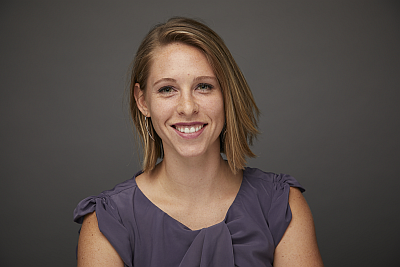 Chelsea Cordes, Aramark Registered Dietitian (RD), knows a thing or two about calories, and she’s here to help us get back to basics, sort through common calorie myths, and maybe even change the way we think about food and weight loss. Read on!
Chelsea Cordes, Aramark Registered Dietitian (RD), knows a thing or two about calories, and she’s here to help us get back to basics, sort through common calorie myths, and maybe even change the way we think about food and weight loss. Read on!
THE CALORIE 411
First things first, Chelsea gives us a quick refresher on calorie need-to-knows:
What is a calorie? Simply put, it’s a unit of energy. The food you eat provides potential energy in the form of calories. The calories that power your daily exercise are the same that fuel your vital body functions.
“Technically, when we talk about the calories we consume or burn, we’re talking about a kilocalorie, which equals 1,000 calories,” Chelsea elaborates. “But in the nutrition and fitness world, we use ‘calories’ for short.”
How many calories are in my food? All foods are made up of one or more macronutrients: protein, carbs, and fat. Each contains a certain amount of potential energy:
- 1 gram of protein = 4 calories
- 1 gram of carbohydrate = 4 calories
- 1 gram of fat = 9 calories
Food manufacturers and restaurants use these figures to calculate the calorie content of their products. “We consumers rely on the calorie counts and other nutritional information posted on food labels, menus, food tracking apps, recipe sites, and so on,” states Chelsea.
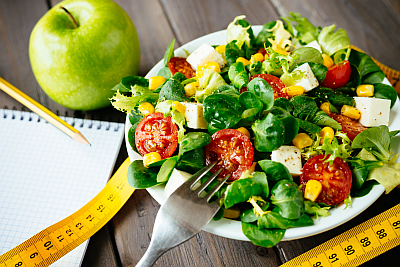 How many calories should I eat? The average person needs about 2,000 calories a day. “But this really is an average,” Chelsea reminds us. “Some people need more; others less.” Gender, height, weight, age, and activity level are among the factors that play a role in how many calories you require.
How many calories should I eat? The average person needs about 2,000 calories a day. “But this really is an average,” Chelsea reminds us. “Some people need more; others less.” Gender, height, weight, age, and activity level are among the factors that play a role in how many calories you require.
This number starts with your basal metabolic rate (BMR)—the amount of energy your body needs to keep your lungs breathing, heart pumping, and more. As Chelsea puts it, “Your BMR is what you would burn if you slept for 24 hours straight. You use this energy no matter what.”
She also says your BMR usually accounts for about two-thirds of your total calorie needs. “So if you eat 2,000 calories a day to maintain your weight, your BMR is likely around 1,340 calories. You use up the rest through general movement, like walking around the house and exercise.” She encourages individuals to connect with an RD like herself who can help determine their recommended daily intake of calories and nutrients.
DON’T FEED INTO THESE CALORIE MYTHS
As with all things nutrition, calorie myths and misconceptions abound. Chelsea chose a few of them to debunk:
- Myth #1: All calories are created equal. A calorie is a calorie, right? Not so much. For example, consider those that come from whole grains versus refined carbs, or from sources of healthy fats versus unhealthy fats. “It’s better to get your calories from foods that give you more nutritional bang for your buck,” Chelsea tells us. “It’s one more reason to choose fish, avocados, and oatmeal over beef, fries, and cookies.”
- Myth #2: Some foods contain negative calories. This myth is rooted in the mistaken idea that certain fruits and vegetables—celery is commonly named—are so low in calories that they actually take more energy to digest them. But this math fails to add up. While a stalk of celery is about 5 or 6 calories, the body uses about 10 to 15% of that to digest it, which amounts to about 1 calorie. “Fruits and veggies are good for you in so many ways, but this myth goes too far,” says Chelsea.
- Myth #3: Exercise is the best way to slash calories. We can all agree that exercise is super-important. But when it comes to shedding calories, what you put on your plate can have a bigger impact. For example, if you weigh 160 pounds, you’d have to walk for about 40 minutes to burn 200 calories. It may be easier to skip your late-night snack to cut those same calories from your day.
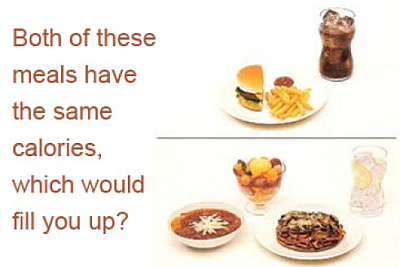 THE BEAUTY OF VOLUMETRICS
THE BEAUTY OF VOLUMETRICS
Did you know that you can fill up on more food while keeping calories in check? The key is to focus on foods that are low in energy density, which means they deliver fewer calories than the same weight (or volume) of high-energy dense choices. This is the concept of volumetrics.
“This approach lets you eat larger portions but not go overboard with calories. Your plate and stomach seem fuller—but you’re actually reducing your calorie intake,” explains Chelsea.
It works because lower energy dense foods are naturally higher in water and fiber, which fill you up and increase satisfaction. They’re also lower in fat. Fat increases a food’s energy density because it has twice as many calories as carbs and protein (though to be clear, your body needs good fats for best health).
Use this guide to build your meals and maximize your daily calories: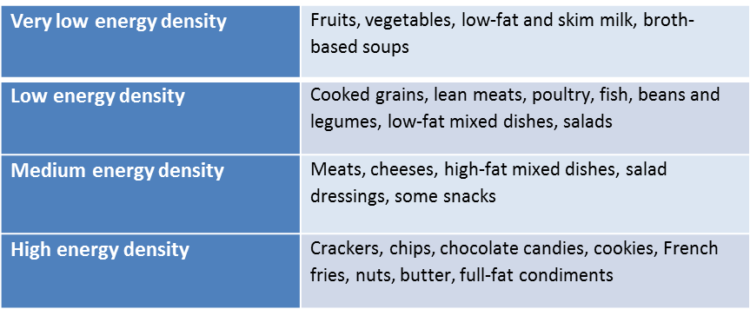
THE BURNING QUESTION
What if you want to lose or gain weight? Generally speaking, if you burn more calories than you take in, you will lose weight. If you eat more than you work off, then that can lead to weight gain. “It’s normal to eat a little more some days, a little less on others. What matters is your pattern over time,” Chelsea assures us.
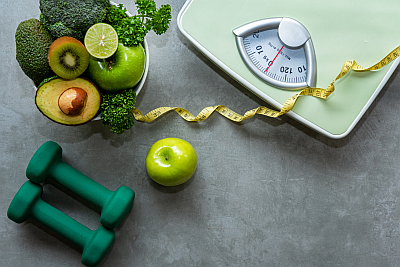 While maintaining a healthy weight is important, she encourages people to think about the bigger picture. “Your primary goals should be to make healthy lifestyle choices. Weight loss comes as an added bonus.”
While maintaining a healthy weight is important, she encourages people to think about the bigger picture. “Your primary goals should be to make healthy lifestyle choices. Weight loss comes as an added bonus.”
When it comes to weight, one size definitely does not fit all. “Just like we all vary in height, eye color, hair type, and so on, what’s considered a healthy weight for you may be different than that of your friends,” says Chelsea. There is no one specific body type that will be ideal for everyone. “A healthy weight generally is one that allows you to comfortably execute the activities of your daily life, get the recommended amount of physical activity, and reduce your risk for developing chronic disease,” says Chelsea. “Reach out to an RD to determine what’s best for you.”
Other tips for a solid weight loss or weight management strategy include:
- Be SMART. This one is borrowed from the business world. The best goals are Specific, Measurable, Attainable, Realistic, and Timely. “Big changes can be hard to achieve and stick to,” explains Chelsea. “By setting SMART goals, you give yourself something to build upon.” For example, instead of pledging to exercise and eat better, commit to being active for at least one hour three days a week, and to choosing three servings of fruits and vegetables each day.
- Don’t overreach. Focus on one or two goals every couple of weeks, and you’re more likely to see success. “Reevaluate after the two-week mark and decide whether you still need to master your current goals or you’re ready to make new ones,” Chelsea says.
- Eat every two to three hours. Skipping meals will only slow your metabolism (how your body turns food and drink into energy)—and leave you feeling pretty cranky. It can even backfire if you wind up eating more later on.
- Steer clear of fad diets. Any eating plan that eliminates one or more major food group is a red flag. You may drop pounds quickly if you cut out carbs, but chances are you’ll regain them (sometimes more) when you start eating those foods again. This is known as yo-yo dieting. “Is it realistic to never touch pizza, fries, or cookies again? Probably not,” Chelsea stresses. “Eating in moderation is a much better long-term solution.”
- Take it slow and steady. Whether you want to lose or gain weight, it should be gradual—no more than 1 to 2 pounds a week. “One pound of body weight equals 3,500 calories, so it takes a difference of 500 per day to see change. You can achieve this through diet, physical activity, or a mix,” Chelsea advises. Again, an RD can help you come up with a plan.
BE CALORIE-CONSCIOUS
Whenever “calorie” feels like a dirty word, remember: Your body needs them to survive!
“Too often, people have negative associations with calories. This can really damage your relationship with food,” Chelsea advises.
The solution? Get the calorie facts, then figure out what works best for your body and your lifestyle. That’s calorie wisdom you can count on.
Note: Since everyone’s health history and nutritional needs are so different, please make sure that you talk with your doctor and a registered dietitian to get advice about the diet and exercise plan that‘s right for you.

